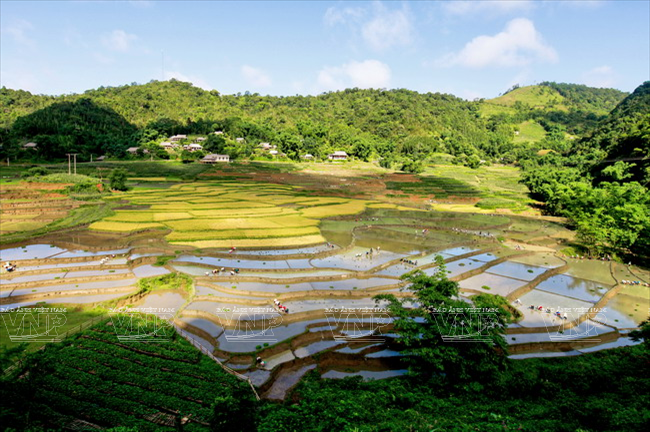Lung Van (Muong Bi), about 40km from downtown Hoa Binh City, is famous for its spectacular natural scenery and the unique culture of the Muong people.

Located at an altitude of 1,200m above sea level, Lung Van in Tan Lac District looks like a fairyland amidst white clouds so it has another name, the Cloud Valley. Lung Van is considered “The Roof of Muong Bi,” one of the four major and the most ancient cultural cradles of the Muong ethnics in Hoa Binh Province, including Muong Bi, Muong Vang, Muong Thang and Muong Dong.
According to the “Land and Water” epic of the Muong ethnic people in Hoa Binh, Lung Van was once a peaceful village which was then completely destroyed by a devastating flood and no one survived after the flood except for a couple who was saved by being stuck in a giant tree, called Bi. The tree had deep roots in 9 rivers and ten mountains so it was not swept away. Having no place to live, the couple built a tent under the tree to live and they reclaimed new land for farming, tamed wild animals for raising, made containers to get water and then established a hamlet and named it after the tree to show their gratitude to the tree that saved their lives. The present-day Muong Bi is a vast mountainous area of many communes in Tan Lac District and Lung Van is the highest place where the Muong ethnic people are living and it is believed to be the place where the Bi tree grew.
Lung Van is now still unfamiliar to many people because it is surrounded by deep blue mountains and is very far from the main road. It has still kept intact many traditional cultural and architectural features, such as tortoise-shaped roofs and Muong women’s dresses which are black and decorated with colourful patterns. Today their dresses are made shorter, suitable for working, however all delicate patterns remain unchanged.
This land is related to many fairy tales and is called the land of longevity because there are many people more than 100 years old who are still healthy. At the age of 90-100, they still work to help their grandchildren. It is believed that the locals’ longevity is due to the water from streams in the region, their good and simple lifestyle and airy and pure atmosphere.
In his notes about culture of Muong areas, culturist Phan Cam Thuong emphasised the difficulties in travelling to the region and the locals’ self-sufficient life. The locals go to their market for entertainment and sometimes exchange their products, such as brocade, woven products, fruit and vegetables. The locals have little money and some have no money.
Lung Van is most beautiful after Tet, from February to April, because at that time it is covered by white clouds. It is also the time the Muong people prepare for a new crop on terraced fields - “A Giant Mirror of Muong Bi”. So far, they have maintained their traditional farming method. Ha Van Binh, an elder in Lung Van said: “We live rather separately so the method of growing rice is quite different from those who live in lower areas. We only start the crop when it rains and the terraced fields are submerged in ‘heaven’s water’. We sow rice by hand that results in low productivity, but is famous for its high quality and delicious taste. Therefore, in the past rice made in Lung Van was used as an offering to hamlet lords, so it is also called ‘the rice of the hamlet lord’.”
With a pure atmosphere, spectacular scenery and peaceful life, Lung Van is really an ideal place for those who want to escape the noisy urban life and discover the unique cultural features of the Muong ethnic people.